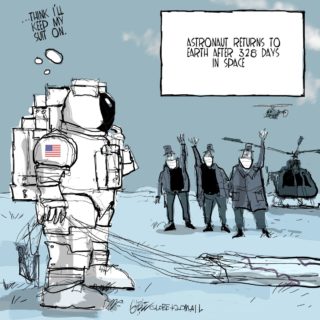The U.S. has pulled its last troops out of Afghanistan, ending a two-decade war and sealing victory by the Taliban’s theocratic terrorists over a coalition of armed forces of the world’s wealthiest countries and their Afghan allies.
The Pentagon announced Monday that the final U.S. military transport plane had departed Kabul’s airport at 11:59 p.m. local time, meeting President Joe Biden’s deadline to withdraw by Aug. 31.
The retreat leaves behind thousands of Afghans – including citizens of the U.S. and Canada – who helped coalition armies, embassies and media, only to find Western governments unable or unwilling to get them to safety amid a chaotic airlift over the last two weeks.
The U.S.-led invasion initially began as an effort to hunt down Afghanistan-based al-Qaeda perpetrators of the Sept. 11, 2001, terror attacks. In the end, it left at least 66,000 troops killed among the coalition’s Afghan allies, along with more than 3,500 dead from the countries that supported the mission. Canada saw 158 soldiers killed in its deadliest conflict since the Korean War.
“I want to thank our commanders and the men and women serving under them for their execution of the dangerous retrograde from Afghanistan as scheduled,” Mr. Biden said in a statement. “Now, our 20-year military presence in Afghanistan has ended.”
The President said the U.S. had evacuated more than 120,000 people from Afghanistan over the last 17 days. Staying longer to airlift more people, he contended, would have been too dangerous and would have damaged long-term prospects for an entente with the Taliban that could allow other Afghans to leave.
The White House said Mr. Biden would deliver a speech on the end of the war Tuesday afternoon.
The withdrawal is in line with a broad political consensus in the U.S., where leaders across the ideological spectrum had come to see the conflict as a fruitless “forever war.” Then-president Donald Trump cut a deal with the Taliban last year that included the pullout Mr. Biden ultimately implemented. Canada ended combat operations in 2011 and pulled out its troops in 2014.
But the execution of the U.S. retreat has come in for heavy criticism. Last month, Mr. Biden insisted that the Afghan National Army could hold off the Taliban on its own. He was quickly proven wrong, as the group overran the country in just eight days.
Hundreds of thousands of Afghans, many of whom worked for coalition forces or the now deposed Western-backed government, clamoured to get out of the country for fear of reprisals from the Taliban. The lack of an apparent plan to make this happen led to deadly stampedes at the airport. Some fell to their deaths after clinging to the landing gear of departing airplanes.
Afghans who worked for the Canadian military and government said Ottawa was slow and bureaucratic in issuing them the documentation they needed to get out of the country. Canada evacuated 3,200 people, but it is unclear how many of those are bound for Canada, since the countries involved in the airlift were pooling evacuation flights.
Last week, an attack on an airport gate by a suicide bomber from ISIS-K, a rival terror group to the Taliban, killed at least 170 Afghans and 13 U.S. troops. On Monday, ISIS-K fired rockets into the airport, but there were no immediate reports of casualties.
As the last U.S. military transport planes took off on Monday, the Associated Press reported, Taliban fighters on the ground celebrated by firing their guns in the air.
“There’s a lot of heartbreak associated with this departure,” General Frank McKenzie, head of U.S. Central Command, said at a news conference announcing the final flights. “We did not get everybody out that we wanted to get out.”
Gen. McKenzie said Ross Wilson, the top American diplomat in the country, was on the final flight.
Secretary of State Antony Blinken said Monday that the U.S. would move its Afghan embassy to Doha, Qatar. But he held out the prospect of granting the Taliban international “legitimacy” if the group fulfills its promises to allow Afghans to leave the country and moderates its misogynistic policies.
“We have no illusions that any of this will be easy or rapid,” Mr. Blinken said. “Any legitimacy and any support will have to be earned.”
The Taliban previously controlled most of Afghanistan between 1996 and 2001. Under their brutal rule, women were banned from working or attending school, while accused adulterers were publicly stoned to death in sports stadiums.
After 9/11, coalition forces and Afghan allies rapidly overthrew the regime as they searched for al-Qaeda leaders who had been harboured by the Taliban. The Taliban then mounted a grinding insurgency that the U.S.-led mission could not stamp out, even as Afghans and Western countries tried to build a democratic government in Kabul.
Mr. Biden was long skeptical of the war effort. In the book Obama’s Wars, journalist Bob Woodward documented behind-the-scenes White House debates in 2009, in which Mr. Biden opposed sending more troops to Afghanistan. Mr. Trump won the 2016 election in part by promising to pull the U.S. back from nation-building efforts abroad.
This alignment between Mr. Biden and Mr. Trump was indicative of the public mood amid the U.S.’s longest-ever war with no end in sight.
“The original sin was the megalomania that unravelled in the aftermath of the 2001 invasion, the idea that one could impose proto-capitalist modernity onto a country like Afghanistan. The question since 2005 has been: How much longer do we keep up this dog-and-pony show?” said Daniel Esser, an expert on Afghanistan at American University in Washington. “For over 15 years it has been very clear that this would not be viable.”
ADRIAN MORROW
U.S. CORRESPONDENT
The Globe and Mail, August 30, 2021

